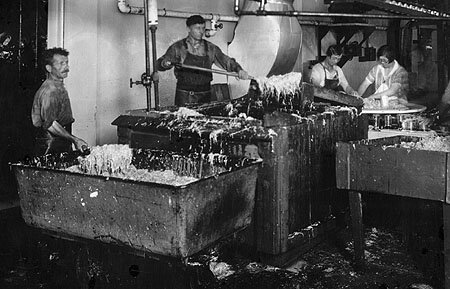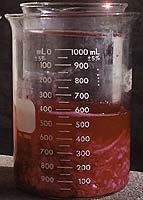Laboratory Exercise in Sauerkraut Fermentation
|
By definition, sauerkraut is "acidic cabbage." It is the result of a natural fermentation by bacteria indigenous to cabbage in the presence of 2 to 3% salt. The fermentation yields lactic acid as the major product. This lactic acid, along with other minor products of fermentation, gives sauerkraut its characteristic flavor and texture. In the production of sauerkraut, mature cabbage heads are washed and shredded. The salt is mixed with the shredded cabbage to a final concentration of about 2.5%. The salted cabbage is then tightly packed into a tierce or crock. The cabbage is protected from air (oxygen) in a manner that will permit gases produced during the fermentation to escape. A temperature of about 70°F is preferred for the fermentation. About five weeks is required for a complete fermentation. The salting of the cabbage serves two major purposes. First, it causes an osmotic imbalance which results in the release of water and nutrients from the cabbage leaves. The fluid expelled is an excellent growth medium for the microorganisms involved in the fermentation. It is rich in sugar and growth factors. Second, the salt concentration used inhibits the growth of many spoilage organisms and pathogens. It does not, obviously, inhibit the desired floral succession. As cabbage is approximately 90% water and the salt is dissolved entirely in the water, the actual salt concentration (brine strength) experienced by the microorganisms in their aquatic milieu is around 2.8%. Thorough and even distribution of the salt is critical. Pockets of low or high salt concentration would result in spoilage and/or lack of the desired fermentation. Throughout the fermentation, it is critical that oxygen be excluded. The presence of oxygen would permit the growth of some spoilage organisms, particularly the acid-loving molds and yeasts. As no starter cultures are added to the system, this is referred to as a wild fermentation. The normal flora of the cabbage leaves is relied upon to include the organisms responsible for a desirable fermentation, one that will enhance preservation and organoleptic acceptability. The floral succession is governed mainly by the pH of the growth medium. Initially, a coliform starts the fermentation. Coliforms which have contributed to our lab-made sauerkraut in recent years have been identified as Klebsiella pneumoniae, K. oxytoca and Enterobacter cloacae. As acid is produced, an environment more favorable for Leuconostoc is quickly formed. The coliform population declines as the population of a strain of Leuconostoc builds. As Leuconostoc is a heterofermentative lactic acid bacterium, much gas (carbon dioxide) accompanies the acid production during this stage. The pH continues to drop, and a strain of Lactobacillus succeeds the Leuconostoc. (On occasion a strain of Pediococcus arises instead of Lactobacillus.) The complete fermentation, then, involves a succession of three major groups or genera of bacteria, a succession governed by the decreasing pH. Sometimes the accumulated acid has been found to kill off the organisms involved in the fermentation. Interesting organisms have been isolated in our food microbiology lab course, including a presumably-coliform, lactose-fermenting organism from an early sample which produced strange-looking colonies on MacConkey Agar. This organism was identified by the API-20E system as Enterobacter agglomerans, a "species" which has been a convenient dumping ground for organisms which may be better identified as Pantoea; certainly this particular strain cannot be regarded as typical of either taxon. In this exercise, cabbage will be appropriately cleaned, shredded and salted. The salted cabbage will be packed into a crock which is then sealed to exclude oxygen. As juice is expressed, it will be plated to monitor the floral succession. The juice will also be titrated to determine the total acidity and to follow the decline in pH. When the fermentation is complete in about five weeks, the organoleptic acceptability of the product will be determined at the Annual Bacteriology Department Kraut-Fest. "MANUFACTURING PERIOD" (t=0 days)Materials
Procedure (to be accomplished by assigned groups of students plus a volunteer clean-up crew)1. Trim the cabbage heads, removing the outer leaves and all bruised or soiled tissue. 2. Wash the trimmed heads thoroughly with tap water. 3. Cut the heads in half, removing the hard, central core. 4. Shred the cabbage with the cabbage shredder. Be careful not to shred your fingers!! 5. Weigh the shredded cabbage. Mix in the salt such that a final concentration of 2.5% is achieved. Complete, even mixing of the salt is highly critical! 6. Pack the shredded cabbage into the crocks, filling to approximately 75-80% of total volume. Compress the mixture moderately while avoiding crushing or bruising the cabbage tissue. 7. Add the lid and weights and finally cover with cheesecloth. 8. Incubate the crocks at 21 to 24°C for 5-6 weeks. PERIODIC PLATING PERIODS
|
| Note: The 0 and 1-day samples will be provided undiluted. The 2 through 35-day samples will be provided in a 1/10 dilution which must be considered in the dilution/plating procedure. |
Materials for pH and acidity determinations
- 1 ten ml sample of sauerkraut juice (undiluted) for titrations
- Erlenmeyer flask
- titration apparatus with 0.1 M NaOH and 1.0% phenolphthalein
- pH paper
Procedure
1. Viable count and direct microscopic observations (to be done by all persons):
- The suggested plated dilutions for the various sampling times are as follows:
day of sample PCA MAC HIAS 0 or 1 10–1,10–2,10–3,10–4 10–2,10–3,10–4,10–5 10–1,10–2,10–3,10–4 2 or 3 10–4,10–5,10–6,10–7 10–4,10–5,10–6,10–7 10–2,10–3,10–4,10–5 4 or 5 10–4,10–5,10–6,10–7 10–3,10–4,10–5,10–6 10–4,10–5,10–6,10–7 14 or 35 10–4,10–5,10–6,10–7 10–2,10–3,10–4,10–5 10–2,10–3,10–4,10–5 - Prepare decimal dilutions of the juice (which may or may not be diluted already to 10–1; see under Materials) and plate 0.1 ml onto each plate such that the plated dilutions indicated above are achieved.
- Incubate all plates at 30°C for 2-3 days.
- Prepare a gram stain of the sample of juice. Observe and record the gram reactions and morphologies of the predominant flora.
2. Acidity and pH determinations (to be done by selected persons on a rotating basis):
- Using pH paper, determine the pH of the undiluted juice sample.
- Add the 10 ml undiluted juice sample to the Erlenmeyer flask. Add 10 ml of distilled water. (Why is the amount of water not critical to the calculations?) Boil the flask for 1 min to drive off the dissolved carbon dioxide. Cool and add 5 drops of phenolphthalein. Titrate with 0.1 M NaOH until a light pink color persists. Using the following formula, calculate the percent lactic acid (the predominant nonvolatile acid expected in the sauerkraut fermentation):
% lactic acid = [(ml of 0.1 M NaOH) X (0.9)] / [sample volume]
COLONY COUNTING AND OBSERVATION PERIODS
(to be done 2-3 days after the corresponding plating period, above)
Materials
- 1 dropper bottle of 3% hydrogen peroxide
Procedure
1. Be sure you have labeled each plate appropriately with the correct plated dilution.
2. Determine the CFUs/ml for each of the following:
- The total aerobic plate count based on the PCA results. Be sure to count all of the colonies, large and small. (Yellow colonies appearing during the early part of the fermentation are most likely plant-associated enteric bacteria belonging to what has been known as the "Erwinia herbicola-Enterobacter agglomerans" group. These organisms are now generally classified as the genus Pantoea.)
- The total gram-negative count based on the MAC results. The coliform count may be estimated by counting the red and pink colonies.
- The total slime-forming colony count based on the count of slimy colonies on HIAS. Count only the relatively large, almost milky or watery-appearing colonies. This count represents the level of Leuconostoc in the sauerkraut.
- The count of lactic acid bacteria may be determined by counting all of the colonies on HIAS. Alternatively, H2O2 can be applied to the PCA plate counted above; the proportion of catalase-negative colonies represents the level of lactic acid bacteria in the sauerkraut.
3. Hand in your results using the form provided. Average class data will be made available for each of the sampling times. A graph showing the total count and the counts of the three bacterial groups (all based on averaged class data) as they "rise and fall" over time will be required. On your graph, be sure you use a correct time scale; do not place the various sampling times at equal intervals!
1998 CLASS RESULTS
Note that in some cases, the total count is less than one of the individual component cultures. However, it is still "in the ball park" and would probably be more realistic with better plating and counting methods and a greater number of individual samples.
Determination of the Lactobacillus count theoretically equals the total lactic acid bacteria count minus the Leuconostoc count. When graphing the results, it's interesting to see how any Lactobacillus count would be eclipsed by the Leuconostoc count for both batches at 5 days. One could wonder if we're possibly detecting "miscellaneous lactics" (not necessarily just Lactobacillus) in the 0-2 day samples.
Batch A
| day | total aerobic plate count/ml | total gram- negative count/ml | total lactic acid bacteria count/ml | Leuconostoc count/ml | % lactic acid |
| 0 | 2.6 X 107 | 7.0 X 106 | 1.4 X 103 | 2.4 X 102 | 0.081 |
| 1 | 4.5 X 106 | 1.0 X 106 | 8.4 X 105 | 8.1 X 105 | 0.086 |
| 2 | 3.7 X 107 | 2.3 X 104 | 1.7 X 106 | 4.8 X 105 | 0.15 |
| 5 | 1.8 X 107 | too few to count |
3.2 X 107 | 3.2 X 107 | 0.42 |
| 14 | 2.1 X 107 | too few to count |
2.2 X 107 | too few to count |
1.4 |
| 35 | 1.9 X 105 | too few to count |
1.3 X 105 | too few to count |
1.6 |
Batch B
| day | total aerobic plate count/ml | total gram- negative count/ml | total lactic acid bacteria count/ml | Leuconostoc count/ml | % lactic acid |
| 0 | 1.2 X 107 | 1.3 X 106 | 4.3 X 103 | 1.8 X 102 | 0.045 |
| 1 | 3.9 X 107 | 3.1 X 105 | 2.6 X 106 | 3.4 X 105 | 0.10 |
| 2 | 1.8 X 108 | 1.1 X 104 | 2.0 X 106 | 7.5 X 105 | 0.18 |
| 5 | 7.2 X 107 | too few to count |
4.0 X 107 | 4.0 X 107 | 0.53 |
| 14 | 3.4 X 107 | too few to count |
2.5 X 107 | too few to count |
1.4 |
| 35 | 3.0 X 106 | too few to count |
3.1 X 106 | too few to count |
1.6 |
|
Go to the 1999 |
These general microbiology pages have copyright by John Lindquist and found their permanent sanctuary on private webservers circa 2001. Copies found elsewhere are neither authorized nor up to date. Page content was last modified on 4/26/17 at 7:00 PM, CDT. Please note the disclaimers above! |

